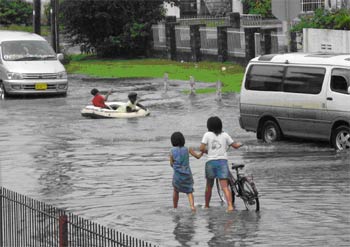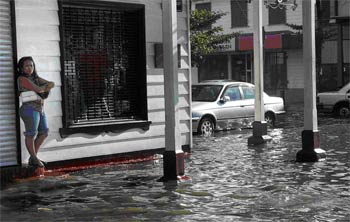Tiempo Climate Cyberlibrary
Politics and Climate Change in Suriname
- Tiempo archive
- Complete issues
- Selected articles
- Cartoons
- Climate treaty
- Latest news
- Secretariat
- National reports
- IPCC
About the Cyberlibrary
The Tiempo Climate Cyberlibrary was developed by Mick Kelly and Sarah Granich on behalf of the Stockholm Environment Institute and the International Institute for Environment and Development, with sponsorship from the Swedish International Development Cooperation Agency.
While every effort is made to ensure that information on this site, and on other sites that are referenced here, is accurate, no liability for loss or damage resulting from use of this information can be accepted.
 |
Maureen Silos outlines the vulnerabilities to climate change confronting Suriname and the difficulties in appropriately and adequately dealing with this urgent issue. |
| The author is Executive Director of the Caribbean Institute in Suriname and is also a contributor to the National Climate Change Action Plan. | |
Suriname, a small nation on the northeast coast of South America, belongs to a special category of 41 low-lying coastal countries that share similar sustainable development challenges, the Small Island Developing States (SIDS). In the Caribbean, these countries are: Antigua and Barbuda, the Bahamas, Barbados, Belize, Cuba, Dominica, Grenada, Guyana, Haiti, Jamaica, St Kitts and Nevis, Saint Lucia, St Vincent and the Grenadines, Suriname and Trinidad and Tobago. Within the discourse on climate change, the SIDS are recognized as a category of nation states with special needs.
Even though these countries have an extremely low greenhouse gas contribution, they will be, and some already are, experiencing the most severe impacts of climate change. Some of these islands and countries will probably disappear as a result of sea-level rise; others will experience severe devastation and may even become uninhabitable.
Suriname is particularly vulnerable to the negative impacts of climate change due to its low-lying coastal zone where we find Suriname's most fertile land, with a concentration of the main economic activities and the majority of the population. Sea-level rise may inundate large parts of this coastal zone. The impact will be significant and could even be catastrophic for the country. Hence, Suriname's major concern is the vulnerability of the coastal zone.
Recent research by Gordon McGranahan of the International Institute for Environment and Development in London and his colleagues is discussed in the April 2007 issue of Environment and Urbanization in the article "The rising tide: assessing the risks of climate change and human settlements in low elevation coastal zones." This article underscores Suriname's vulnerability by reporting that, "the ten countries with the largest share of their population living within ten metres of sea level are:
The Bahamas, 88 per cent of population; Suriname, 76 per cent of population; The Netherlands, 74 per cent of population; Vietnam, 55 per cent of population; Guyana, 55 per cent of population; Bangladesh, 46 per cent of population; Djibouti, 41 per cent of population; Belize, 40 per cent of population; Egypt, 38 per cent of population; and, The Gambia, 38 per cent of population".
The National Institute for Environment and Development provided the data and statistics, in 2005, for Suriname's First National Communication to the United Nations Framework Convention on Climate Change ( 1.4Mb download). In the Initial National Communication, the government of Suriname states that sea-level rise will result in "increased erosion, large-scale inundation, loss of fertile land, reduction of freshwater resources, decline of biodiversity, and worsening of human health". The report goes on to say that "climate change is likely to result in changes in the hydrological cycle, including rainfall, its intensity and distribution, and droughts. The combined effect of these changes makes the country vulnerable to climate change."
Local politics
In early May 2006, the interior of Suriname experienced unprecedented extreme rainfall that caused severe flooding of large areas in southern Suriname, affecting approximately 49,000 indigenous and Maroon people. The Economic Commission for Latin America and the Caribbean estimates the damage to the area had a financial cost of around US$40 million, and predicts that the area will need about five to ten years of intensive special assistance to recover from the disaster. Food security was especially threatened with most of the subsistence plots flooded.
 |
Flooding in the suburbs of Paramaribo, May 2007 |
In May 2007, at the start of the rainy season, the capital, Paramaribo, experienced unprecedented flooding. Even though seasonal flooding of the city is an annually recurring phenomenon because of the bad state of the drainage system, this time the flooding affected areas that had not experienced this before and the water stayed for days in certain neighborhoods. The government was at a loss and blamed global warming for the severity of the rain and the flooding, just as it did with the flooding of the interior.
"Wan ogri e tja wan bun." This is Surinamese Creole for "A bad thing always brings a good thing". The extreme flooding of both the interior and the capital city raised awareness on one of the effects of climate change and underscored the fact that the government is woefully unprepared to respond effectively to disasters or to prevent these from happening. In addition, the flooding also illustrated the political reasons for this lack of capacity.
Politics in Suriname is characterized by a colonial world view and an ethnic group mentality. Political loyalties are very strongly tied to groups and, because of its multi-ethnicity, the loyalties are tied to one's ethnic group. That is why the formation of coalitions that could transcend these ethnic groups is almost impossible. Forming coalitions would entail that people would have to be able to find each other on the basis of political principles and policy issues, and this is not possible in a political system that emphasizes ethnic group loyalties.
 |
Flooding in downtown Paramaribo, May 2007 |
Surinamese political culture is also very authoritarian. Carl Stone, a Caribbean political scientist, says that "there is a strong tendency to elevate and defer to political leaders as if they were transcendental authority figures standing at some great distance above the political system. These leaders are (in their moments of high popularity) invested with extraordinary qualities of wisdom and pampered with emotional displays of ritual subservience by party followers. Party leaders are put on a pedestal by cabinet members, parliamentarians, party activists and other members of the party elite. The effect is a tendency for the party leader to assume a sense of personal authority and power that is inconsistent with leadership accountability and a strong democratic system."
The current government of Suriname is a coalition of five parties, four of which are organized around an ethnic identity of either Blacks, East Indians, Javanese or Maroons, and a tiny Labor Party which has a primarily black membership. They came together to form a government in a culture where the government is historically seen as an opportunity to use the state for corruption and to further the interests of the elites of these ethnic groups. These parties are actually redistribution cartels, primarily redistributing the spoils from development aid and taxes. Sixty per cent of the population is in government service, and even though political leaders talk about 'public sector reform', not much is going to happen soon because giving away jobs in the civil service is one of the means to buy political loyalty and votes at election time.
In this context, only lip service is paid to the issue of climate change and its effect on the country. Even then, this is mainly as a result of funding from international organizations such as the United Nations Development Programme. In effect, it is international organizations and foreign governments, such as the Dutch government, that are pushing the issue of climate change on the Surinamese government and are more or less forcing the government to make some moves so that it might appear to be adhering to the requirements of the international treaties that it has signed. To really address climate change issues, politicians and policy makers have to transcend their tribal thinking and begin to identify with the interests of the larger society and of future generations.
Climate change and adaptation in Suriname
Suriname ratified the United Nations Framework Convention on Climate Change in 1997. Its First National Communication was only submitted in March 2006. This reporting was made possible as part of a large grant from the United Nations Development Programme to help Suriname comply with the requirements of the Convention. That grant also provided funds for a large-scale climate change awareness campaign in 2006 and for writing a National Climate Change Action Plan in 2007.
The process for writing the National Action Plan was participatory and coastal communities that are already experiencing the negative impacts of sea-level rise were extensively consulted. At the end of these community consultations, there was a national climate change workshop in Paramaribo in which participants from government agencies, the university and the private consultancy sectors came together to comment on the draft National Action Plan. This draft focuses primarily on adaptation measures for the coastal zone because this will be hit the hardest.
As a result, the areas that have been identified as in need of adaptation measures are:
- the coast and river banks;
- water sources;
- public health;
- agricultural production;
- energy;
- education and awareness;
- capacity development;
- scientific research; and,
- fund-raising to finance the implementation of adaptation measures.
The following areas have been identified for mitigation measures: the large-scale mechanical rice sector; the transport sector; the forestry sector; and the waste management sector.
Spatial planning is crucial for the success of adaptation measures in the coastal zone. One reason is the importance of the mangrove forest for coastal and riverbank protection. Suriname urgently needs a zoning plan that incorporates a buffer zone as protection against sea-level rise. This zoning plan should be codified in a law on spatial planning to prevent arbitrary changes in policy resulting from changes in government coalitions.
In this buffer zone, the government can monitor and control any changes in the coast and river banks. Because of the horse trading between the coalition partners after the elections two years ago, however, a new Ministry of Spatial Planning and Land Management was created to appease one of the coalition members (a Javanese political party) who threatened to leave the coalition and join the opposition if this fiefdom was not provided. The Ministry of Natural Resources was stripped down to a bare minimum of functions to accommodate this particular political party with a new ministry. The result is that spatial planning is not on the agenda of the government, and the only press this new ministry gets is anger around the granting of land titles to loyalists of the political leader of that party.
Climate change and adaptation are not on the priority policy agenda of this new ministry. This ministry also does not have any official opinion about the recommendations made by climate scientists, civil engineers and the Inter-American Development Bank on integrated coastal zone management. In 2005, the Inter-American Development Bank financed the write-up of the terms of reference for a comprehensive coastal zone management plan. The write-up is not used and seems to have vanished into a drawer somewhere.
In conclusion
There is a large discrepancy and disconnect between the intent of the United Nations Framework Convention on Climate Change that has been ratified by Suriname and the actual practice of preparing for the negative impacts of climate change on this country. Government reports to the Convention Secretariat paint a picture of a situation in which the government is actively engaged in adaptation and mitigation policies. As with other urgent issues of sustainable development in Suriname, these reports are, at best, window dressing that masks the reality of political decision-making that is undemocratic, authoritarian and completely focused on the short-term narrow sectarian interests of ethnic politics.
A society is, however, more than its political culture, and there is growing pressure on the government from civil society to do the right thing. People are speaking out, the media is more informed, and it seems that the government's arguments to paper over its incompetence are increasingly less persuasive.
Eventually, this political culture will be succeeded by another, hopefully more modern one, based on democratized political parties. Then, government, business and civil society can work together to implement recommendations and policies that will allow Suriname to protect itself against the adverse effects of global warming and climate change.
I can only hope that it will not be too late.
Further information
Maureen Silos, The Caribbean Institute, Hoekstrastraat 5, Paramaribo, Suriname. Email: maureensilos@sr.net. Web: www.caribbean-institute.org.
On the Web
The Tiempo Climate Cyberlibrary maintains a listing of key websites covering small island developing states.
Bright Ideas

General Electric plans to cut solar installation costs by half

Project 90 by 2030 supports South African school children and managers reduce their carbon footprint through its Club programme

Bath & North East Somerset Council in the United Kingdom has installed smart LED carriageway lighting that automatically adjusts to light and traffic levels

The United States National Oceanic and Atmospheric Administration and the American Public Gardens Association are mounting an educational exhibit at Longwood Gardens showing the link between temperature and planting zones

The energy-efficient Crowne Plaza Copenhagen Towers hotel is powered by renewable and sustainable sources, including integrated solar photovoltaics and guest-powered bicycles
El Hierro, one of the Canary Islands, plans to generate 80 per cent of its energy from renewable sources

The green roof on the Remarkables Primary School in New Zealand reduces stormwater runoff, provides insulation and doubles as an outdoor classroom

The Weather Info for All project aims to roll out up to five thousand automatic weather observation stations throughout Africa

SolSource turns its own waste heat into electricity or stores it in thermal fabrics, harnessing the sun's energy for cooking and electricity for low-income families

The Wave House uses vegetation for its architectural and environmental qualities, and especially in terms of thermal insulation

The Mbale compost-processing plant in Uganda produces cheaper fertilizer and reduces greenhouse gas emissions

At Casa Grande, Frito-Lay has reduced energy consumption by nearly a fifth since 2006 by, amongst other things, installing a heat recovery system to preheat cooking oil
Updated: May 15th 2015